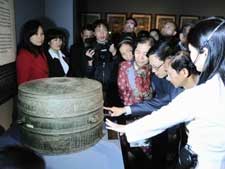An exhibition entitled "Vietnam's Buddhism Culture" officially opened at the Vietnam National Museum of History on February 25.
 The six-month exhibition introduces visitors to nearly 200 documents and objects that describe the development of Buddhism in Vietnam since the religion was introduced to the country 1,000 years ago.
The six-month exhibition introduces visitors to nearly 200 documents and objects that describe the development of Buddhism in Vietnam since the religion was introduced to the country 1,000 years ago.
On display are paintings, statues, worshipping objects and musical instrument, as well as local Buddhist architecture.
The exhibition brings back the dawn of Vietnam's Buddhism, which originated from Luy Lau Buddhism in the north, ancient Champa's Buddhism in the centre of the country, and Oc Eo culture in the south.
During the Ly-Tran dynasty from the 11 th to the 13 th century, Buddhism flourished with remarkable impacts on various socio-cultural aspects, and was considered the national religion. Truc Lam Zen Buddhism was founded by King Tran Nhan Tong during this period, marking Vietnam's independent religious development. Many temples were constructed such as Bao Thien, Dam, Phat Tich, Thay, Pho Minh and Boi Khe.
After the Ly-Tran dynasty, Confucianism became the official ideology and the foundation to build political and social institutions. However, Buddhism, with its strong vitality, was still followed by people of various classes in society and gradually recovered in the Mac dynasty in the 16 th century.
The museum exhibits the national treasure Canh Thinh Bronze Drum of the Tay Son dynasty, which represents the spiritual and religious value of the Vietnamese people over thousands of years.
During the Nguyen dynasty in the 19 th century, numerous temples were restored nationwide, bequeathing large and valuable cultural heritages.
The documents and objects will be on display until August, 2013, at the National Museum of History, No. 25 Tong Dan Street, Hanoi.